Sources
- The Annals of Fulda . (Manchester Medieval Series, Ninth-Century Histories, Volume II.) Reuter, Timothy (trans.) Manchester: Manchester University Press, 1992.
Thacholf, Thachulf, Thaculf, or Thakulf (died 1 August 873) was the Duke of Thuringia from 849 until his death. He held the titles of comes (count) and dux (duke) and he ruled over a marca (march). He may have been the son of Hadulf, son of Thankulf.
Thachulf was placed in charge of the Sorbian March in 849 with the title of dux Sorabici limitis, giving him military command over the counts with lands bordering the Sorbs. On account of his knowledge of Slavic customs, he was petitioned by the Sorbs with the offer of hostages for peace to protect them from the warmaking of Ernest, Duke of Bavaria, but he had been wounded in battle the day before the arrival of the Slav embassy and so could not be of assistance. Hiding his injury from the Slav delegates, he sent men to the other leaders of the Frankish host proposing terms with the Slavs, but the other generals suspected him of a coup to assume supreme command of the army and so ignored his representatives and made war anyway, being badly defeated in the process.
According to the Annales Fuldenses , in 858, a Reichstag held at Frankfurt under Louis the German sent three armies to the eastern frontiers to reinforce the submission of the Slavic tribes. Carloman was sent against Great Moravia, Louis the Younger against the Obodrites and Linonen, and Thachulf against the Sorbs, who were refusing to obey him. The armies of Carloman and Louis set out in July, but it is uncertain if Thachulf ever undertook a campaign, as the Sorbs rose in rebellion late in that year and do not appear to have been restless beforehand. The Annales Fuldenses may be incorrect about the timing of Thachulf's command to send an army against them.
Thachulf died in the summer of 873. His death was immediately followed by the revolt of the Sorbs, Siusli, and their neighbours. The revolt was not put down until Liutbert and Radulf, Thachulf's successor, campaigned in January 874.

Arnulf of Carinthia was the duke of Carinthia who overthrew his uncle Emperor Charles the Fat to become the Carolingian king of East Francia from 887, the disputed king of Italy from 894 and the disputed emperor from February 22, 896, until his death at Regensburg, Bavaria.
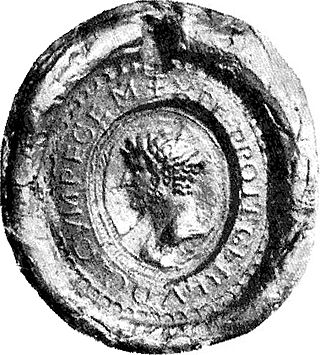
Louis the German, also known as Louis II of Germany and Louis II of East Francia, was the first king of East Francia, and ruled from 843 to 876 AD. Grandson of emperor Charlemagne and the third son of Louis the Pious, emperor of Francia, and his first wife, Ermengarde of Hesbaye, he received the appellation Germanicus shortly after his death, when East Francia became known as the kingdom of Germany.

Carloman was a Frankish king of the Carolingian dynasty. He was the eldest son of Louis the German, king of East Francia, and Hemma, daughter of a Bavarian count. His father appointed him governor of Carantania in 856, and commander of southeastern frontier marches in 864. Upon his father's death in 876 he became King of Bavaria. He was appointed by King Louis II of Italy as his successor, but the Kingdom of Italy was taken by his uncle Charles the Bald in 875. Carloman only conquered it in 877. In 879 he was incapacitated, perhaps by a stroke, and abdicated his domains in favour of his younger brothers: Bavaria to Louis the Younger and Italy to Charles the Fat.
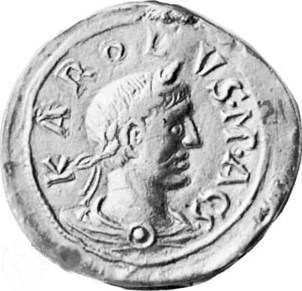
Charles III, also known as Charles the Fat, was the emperor of the Carolingian Empire from 881 to 888. A member of the Carolingian dynasty, Charles was the youngest son of Louis the German and Hemma, and a great-grandson of Charlemagne. He was the last Carolingian emperor of legitimate birth and the last to rule a united kingdom of the Franks.

Zwentibold, a member of the Carolingian dynasty, was the illegitimate son of Emperor Arnulf. In 895, his father granted him the Kingdom of Lotharingia, which he ruled until his death.
Bernardof Septimania (795–844), son of William of Gellone, who was the cousin of Charlemagne and was the Frankish Duke of Septimania and Count of Barcelona from 826 to 832 and again from 835 to his execution. He was also count of Carcassonne from 837. He was appointed to succeed his fellow Frank Rampon. During his career, he was one of the closest counsellors of the Emperor Louis the Pious, a leading proponent of the war against the Moors, and opponent of the interests of the local Visigothic nobility.
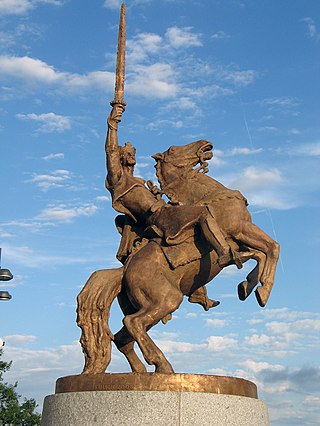
Svatopluk I or Svätopluk I, also known as Svatopluk the Great, was a ruler of Great Moravia, which attained its maximum territorial expansion during his reign.
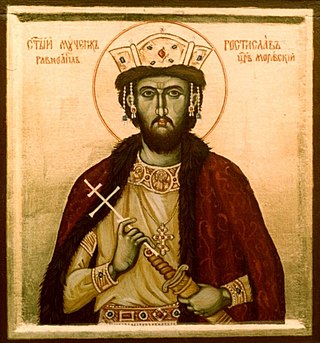
Rastislav or Rostislav, also known as St. Rastislav, was the second known ruler of Moravia (846–870). Although he started his reign as vassal to Louis the German, king of East Francia, he consolidated his rule to the extent that after 855 he was able to repel a series of Frankish attacks. Upon his initiative, brothers Cyril and Methodius, sent by the Byzantine Emperor Michael III in 863, translated the most important Christian liturgical books into Slavonic. Rastislav was dethroned by his nephew Svatopluk I of Moravia, who handed him over to the Franks. He was canonized by the Eastern Orthodox Church in 1994.

Bruno, also called Brun or Braun, a member of the Ottonian dynasty, was Duke of Saxony from 866 until his death. He is rated as an ancestor of the Brunonids, a cadet branch of the Ottonians, though an affiliation is uncertain. Bruno was killed fighting against Norse warriors in the Battle of Lüneburg Heath and is venerated as one of the Ebsdorf Martyrs.
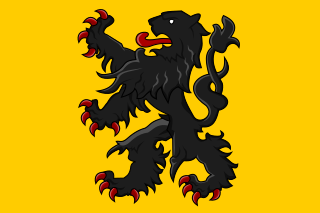
The Margravate of Meissen was a medieval principality in the area of the modern German state of Saxony. It originally was a frontier march of the Holy Roman Empire, created out of the vast Marca Geronis in 965. Under the rule of the Wettin dynasty, the margravate finally merged with the former Duchy of Saxe-Wittenberg into the Saxon Electorate by 1423.
Pribina was a Slavic prince whose adventurous career, recorded in the Conversion of the Bavarians and the Carantanians, illustrates the political volatility of the Franco–Slavic frontiers of his time. Pribina was the first ruler of Slavic origin to build a Christian church on Slavic territory in Nitra, and also the first to accept baptism.
Slavomir was a duke of Moravia (871). He led a revolt against the Franks who had annexed Moravia during the incarceration of his relative, Svatopluk I.
Thrasco was the Prince (knyaz) of the Obotrite confederation from 795 until his death in 810. He succeeded his father, Witzlaus II, who had been ambushed and killed by the revolting Saxons. Thrasco defeated the Saxons in the battle on Schwentine River in 798. He was murdered in Reric in 810. Thrasco had a son, Cedragus, the Obotrite prince from 819 to 826.

The March of Carinthia was a frontier district (march) of the Carolingian Empire created in 889. Before it was a march, it had been a principality or duchy ruled by native-born Slavic princes at first independently and then under Bavarian and subsequently Frankish suzerainty. The realm was divided into counties which, after the succession of the Carinthian duke to the East Frankish throne, were united in the hands of a single authority. When the march of Carinthia was raised into a Duchy in 976, a new Carinthian march was created. It became the later March of Styria.
Radulf or Ratolf was the Duke of Thuringia from 874 until his death. Radulf was the successor and possibly son of Thachulf.
Poppo II or Boppo II was the Duke of Thuringia from 880 until his deposition in 892.
Rodulf Haraldsson, sometimes Rudolf, from Old Norse Hróðulfr, was a Viking leader who raided the British Isles, West Francia, Frisia, and Lotharingia in the 860s and 870s. He was a son of Harald the Younger and thus a nephew of Rorik of Dorestad, and a relative of both Harald Klak and Godfrid Haraldsson, but he was "the black sheep of the family". He was baptised, but under what circumstances is unknown. His career is obscure, but similar accounts are found in the three major series of Reichsannalen from the period: the Annales Bertiniani from West Francia, the Annales Fuldenses from East Francia, and the Annales Xantenses from Middle Francia. He died in an unsuccessful attempt to impose a danegeld on the locals of the Ostergo.
Louis the Younger, sometimes Louis the Saxon or Louis III, was the second eldest of the three sons of Louis the German and Emma. He succeeded his father as the King of Saxony on 28 August 876 and his elder brother Carloman as King of Bavaria from 876 to 882. He died in 882 and was succeeded in all his territories, which encompassed most of East Francia, by his younger brother, Charles the Fat, already king of Italy and emperor.
The Duchy of Thuringia was an eastern frontier march of the Merovingian kingdom of Austrasia, established about 631 by King Dagobert I after his troops had been defeated by the forces of the Slavic confederation of Samo at the Battle of Wogastisburg. It was recreated in the Carolingian Empire and its dukes were appointed by the king until it was absorbed by the Saxon dukes in 908. From about 1111/12 the territory was ruled by the Landgraves of Thuringia as Princes of the Holy Roman Empire.
Radbod was the East Frankish prefect of the Eastern March, the Bavarian frontier towards the Slavs, appointed in 833. He had been appointed the office after Louis the German's conquest in 828, and subsequent Christianization of the Moravians (828–33). In 833, according to the Conversio Bagoariorum et Carantanorum, a Slavic prince, Pribina, had been "driven across the Danube by Mojmir, duke of the Moravians", and fled to Radbod in East Francia around 833. Radbod introduced him to King Louis the German, who ordered that Pribina should be "instructed in the faith and baptized", and that he serve with his followers in Radbod's army. Before long, however, Radbod and Pribina fell out, and the latter, fearing for his life, fled with his son Koceľ to the First Bulgarian Empire, and then to Lower Pannonia ruled by a Slavic duke, Ratimir. Since Lower Pannonia was part of Radbod's prefecture, Ratimir's harboring of Pribina was tantamount to rebellion, therefore, in 838, Louis the German sent Radbod at the head of a large Bavarian army to crush Ratimir, but Pribina and his followers took refuge with the count of Carniola, Salacho. In short time the latter brokered a reconciliation between Radbod and Pribina, and Louis solved the ongoing instability by appointing Pribina as his faithful dux with lands in around the Zala river. Radbod held contacts with Rastislav, ruler of the Moravians, who had long posed a danger to Bavaria. According to the Annals of St-Bertin, in 853 Charles the Bald, king of West Francia, bribed the Bulgarians to ally with the Slavs and together attack Louis the German's kingdom. In the course of the Bulgarian–Moravian attack, Louis the German deposed Radbod in 854 for infidelity, after an uprising. Radbod then formed a rebel alliance with Rastislav. In 855, Rastislav (Rastiz) rebelled, and Carloman was made prefect in Radbod's place in 856. Carloman's 858 campaign forced Rastislav to make peace.